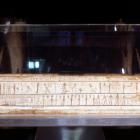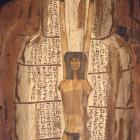The sarcophagi of Peftjauauyaset, stuccoed and painted cedar wood, Late Period, 26th Dynasty (7th century BC), from Thebes (inv. n. E 0.9.40147-0.9.40148)
The anthropoid sarcophagus and the coffin contained within were donated to the Brera Library in 1830, by Austria’s consul general to Egypt, Giuseppe Acerbi. The sarcophagus belonged to a high ranking individual, as can be inferred from the refined stylistic execution of the face and decorations. The sky goddess Nut is depicted on the exterior of the sarcophagus holding the symbol of life (ankh) while kneeling between her sisters, the goddesses, Isis and Nephthys. Below Nut is engraved a vertical band of hieroglyphs, once filled with colored glass paste, carrying the name of the deceased. On the inner surface of the lid, to the side of the goddess Nut, depicted lying down, is a funerary ritual (known as the Hourly Vigils), that marked the protection of the deceased during the hours of the day and night following his or her death. Inside the sarcophagus is the goddess of the West, Imentet, who represents the land that receives the remains of the deceased. The coffin however, of which only the bottom remains, is decorated only externally with funerary deities placed on different registers.









